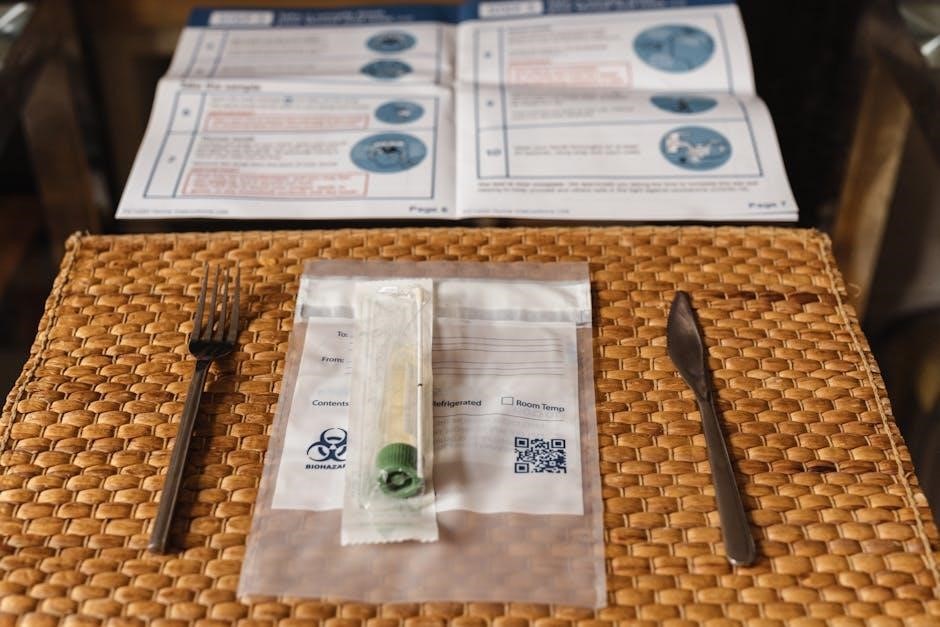Surgifoam is a sterile, absorbable gelatin sponge used for hemostasis in surgical procedures. It is malleable, can be cut to size, and applied directly to bleeding surfaces.
1.1 Overview of Surgifoam
Surgifoam is a sterile, absorbable gelatin sponge or powder used for hemostasis in surgical procedures. It is water-insoluble, malleable, and can be cut to size. The sponge is applied directly to bleeding surfaces to control blood flow. Surgifoam is not intended to act as a tampon or plug but rather to promote clotting. It is available in different sizes, such as 12 cm² and 100 cm². The product is designed for single-use and should be applied immediately after opening the package. It can also be used with thrombin if needed, but this is not always necessary. Always follow the provided instructions for use.
1.2 Importance of Following Instructions
Adhering to the instructions for Surgifoam is crucial for safe and effective use. Proper preparation, such as cutting to size and compressing the sponge, ensures optimal performance. Improper use can lead to reduced efficacy or complications. The sponge should not be used in the presence of infection, as it may exacerbate the condition. Always refer to the package insert or Instructions for Use (IFU) provided by the manufacturer. Following these guidelines minimizes risks and ensures the product functions as intended during surgical procedures. Compliance with sterilization and storage recommendations is also essential to maintain product integrity.

Preparation of Surgifoam
Cut Surgifoam to the desired size and shape using sterile instruments. Compress the sponge before application to ensure proper fit and effectiveness at the bleeding site.
2.1 Cutting Surgifoam to Size
Using sterile scissors or surgical instruments, cut Surgifoam to the desired size and shape. Ensure the sponge fits the bleeding site without overlapping healthy tissue. Compress the sponge gently to achieve the optimal thickness for effective hemostasis. Proper sizing is crucial to avoid improper absorption and ensure even pressure distribution. Always handle Surgifoam with sterile gloves or instruments to maintain its integrity and prevent contamination. The sponge can be molded or reshaped as needed before application. Sizes like 12 cm² (20 mm x 60 mm) and 100 cm² (80 mm x 125 mm) are available for various surgical needs.
2.2 Compressing the Sponge
Before application, compress the Surgifoam sponge gently but firmly using sterile gloves or instruments. This step reduces its thickness and enhances its absorbency. Ensure the sponge remains intact during compression to maintain its hemostatic properties. Avoid over-compression, as it may reduce effectiveness. Compressing helps the sponge conform better to the bleeding site, promoting even absorption and pressure distribution. Always handle the sponge in a sterile manner to prevent contamination. This step is crucial for optimal performance in achieving hemostasis during surgical procedures.
2.3 Preparing the Bleeding Site
Before applying Surgifoam, ensure the bleeding site is clean and free of debris. Gently irrigate the area with sterile saline solution to remove any contaminants or excess blood. Use suction to maintain a clear field, allowing precise placement of the sponge. Pat the site dry with sterile gauze to enhance adhesion and absorption. Avoid touching the bleeding tissue unnecessarily to prevent further irritation. Proper preparation ensures optimal contact between the sponge and the tissue, maximizing its hemostatic effectiveness. This step is critical for achieving rapid and reliable bleeding control during surgical or traumatic situations.

Application of Surgifoam
The application of Surgifoam requires surgical precision to ensure effective bleeding control. Properly prepared sponges are placed directly onto the bleeding site, maintaining direct contact for optimal absorption and hemostasis.
3.1 Holding the Sponge
Properly holding the Surgifoam sponge is crucial for effective application. Using sterile gloves, grasp the sponge firmly but gently to avoid compressing it prematurely. Hold it between your thumb and index finger, ensuring the sponge’s surface remains flat and even. Avoid touching the sponge excessively to prevent contamination. When handling, maintain direct contact with the sterile wrapper until placement. Proper handling ensures the sponge retains its structure and absorptive capacity, promoting optimal hemostasis. Improper handling can reduce efficacy or lead to improper placement, potentially compromising bleeding control. Always follow sterile technique to maintain surgical site integrity.
3.2 Applying to the Bleeding Surface
When applying Surgifoam to the bleeding surface, ensure the area is visibly clean and accessible. Gently place the sponge directly onto the bleeding site using sterile tweezers or gloved hands; Apply firm, even pressure to secure the sponge, ensuring full contact with the tissue. Avoid overlapping or stacking multiple sponges, as this can reduce effectiveness. For deep or irregular wounds, shape the sponge to fit the contours of the tissue. Once applied, the sponge should remain in place until hemostasis is achieved or as directed by surgical protocol. Proper placement is key to maximizing absorbency and promoting effective bleeding control.
3.4 Securing the Sponge
To secure Surgifoam, ensure it adheres firmly to the bleeding surface. Use sterile sutures, staples, or surgical dressings to hold it in place, especially in deep wounds. Apply consistent pressure for 1-2 minutes to enhance adhesion. Avoid displacing the sponge during securing. In open wounds, cover with a sterile dressing to maintain pressure and protect the site. Monitor the area to ensure the sponge remains securely positioned. Securing the sponge properly prevents dislodgment and ensures effective hemostasis, minimizing the risk of further bleeding or complications during recovery.

Special Instructions
Adhere to specific guidelines when using Surgifoam, such as applying with thrombin for enhanced effectiveness, managing multiple bleeding sites, and following infection prevention protocols strictly.
4.1 Using Surgifoam with Thrombin
When using Surgifoam with thrombin, ensure proper mixing to enhance hemostatic effectiveness. Apply thrombin solution directly to the sponge or mix with saline before placement. This combination accelerates clot formation, especially in challenging surgical scenarios. Always follow manufacturer guidelines for thrombin concentration and application to avoid adverse reactions. Proper preparation ensures optimal results in controlling bleeding during procedures.
4.2 Handling Multiple Bleeding Sites
When managing multiple bleeding sites with Surgifoam, prioritize sites based on severity. Apply Surgifoam to the most critical areas first to control significant blood loss. Prepare multiple sponges in advance, ensuring each is appropriately sized for the wound. Labeling each sponge can help maintain organization. Gently press each sponge onto the bleeding site, ensuring firm contact for optimal effectiveness. Monitor each site closely to confirm bleeding cessation. If overwhelmed, seek additional surgical assistance to ensure all sites are adequately addressed. Proper management of multiple sites prevents complications and promotes patient stability.
4.3 Avoiding Infection Risks
To minimize infection risks when using Surgifoam, always handle the sponge with sterile gloves. Ensure the application site is cleaned and disinfected before placing the sponge. Avoid touching the sponge’s surface to prevent contamination. Use sterile saline solution to moisten the sponge if necessary. After application, monitor the site for signs of infection, such as redness or pus. If infection is suspected, remove the sponge promptly and follow standard wound care protocols. Proper handling and adherence to sterile technique are critical to reducing infection risks and ensuring effective wound management.

Post-Application Care
Monitor the site for healing progress and complications. Ensure the area remains clean and dry to promote recovery. Follow medical advice for optimal wound management.
5.1 Monitoring the Site
After applying Surgifoam, closely monitor the site for signs of bleeding cessation, such as a stable, dry surface. Check for any adverse reactions, like excessive swelling or redness. Ensure the area remains clean to prevent infection. Regularly inspect the sponge’s position and integrity. If bleeding resumes or the sponge shifts, notify a healthcare provider promptly. Monitoring should continue until the sponge is removed, typically within 24-48 hours. Maintain a sterile environment and avoid disturbing the site unnecessarily. Follow post-operative care instructions provided by your healthcare team to ensure proper healing and minimize complications.
5.2 Removing the Sponge
Removal of Surgifoam should be performed by a healthcare professional in a sterile environment; Wet the sponge with saline solution to minimize tissue adherence. Gently irrigate the area to loosen the sponge without causing damage. Avoid pulling or tugging forcefully, as this may disrupt the healing tissue. Once removed, inspect the site for residual material or bleeding. Ensure complete removal to prevent infection or delayed healing. Dispose of the sponge according to biohazard protocols. After removal, reassess the wound and apply appropriate dressing if necessary. Document the process and monitor the site for any complications.
5.3 Wound Cleaning
Use sterile saline solution to clean the wound after Surgifoam removal. Avoid harsh chemicals to prevent tissue irritation. Gently irrigate the area to remove debris without damaging healing tissue. If prescribed, apply antiseptic solutions to reduce infection risk. After cleaning, pat the area dry with a sterile towel. Apply antibiotic ointment to promote healing and prevent infection. Cover with a sterile dressing to protect the wound. Follow healthcare provider instructions for specific care routines. Regular wound cleaning helps ensure proper healing and minimizes complications. Maintain a clean environment to promote tissue repair and prevent infection.

Safety Guidelines
Always handle Surgifoam with clean, gloved hands to minimize contamination. Store in a cool, dry place, away from direct sunlight. Dispose of unused portions in biohazard containers. Avoid contact with eyes or open wounds. Follow proper infection control measures during application and removal. Ensure all packaging is intact before use to maintain sterility. Adhere to hospital protocols for handling surgical materials to ensure patient and user safety.
6.1 Contraindications
Surgifoam is contraindicated in patients with known allergies to gelatin or bovine-derived products. It should not be used in closed surgical spaces or on dry surfaces, as this may impair its effectiveness. Avoid applying Surgifoam directly on exposed blood vessels or nerves. Do not use in cases of uncontrolled bleeding or where active bleeding is not present. Surgifoam is not intended for use in ophthalmic or intravascular procedures. Patients with a history of severe allergic reactions to hemostatic agents should be closely monitored. Always consult the product label for specific contraindications and precautions to ensure safe and appropriate use.
6.2 Storage and Disposal
Store Surgifoam in a cool, dry place, away from direct sunlight and moisture. The product should be kept at room temperature (15°C to 30°C) and protected from contamination. Do not expose Surgifoam to extreme temperatures or humidity. Opened packages must be used immediately or discarded if not used within the procedure. Dispose of used Surgifoam as biohazardous waste, following local regulations and medical facility protocols. Properly seal and label waste containers to prevent accidental exposure. Do not reuse or resterilize Surgifoam, as this may compromise its effectiveness and safety.
6.3 Handling Opened Packages
After opening Surgifoam, handle the contents with care to maintain sterility. Always wear sterile gloves or use sterile forceps when touching the sponge. If the package is opened but not immediately used, ensure it is stored in a sterile, sealed container to prevent contamination. Use the product within 24 hours of opening. Do not reuse an opened package for multiple procedures, as this may compromise safety and efficacy. Dispose of any unused portions as biohazardous waste, adhering to local medical protocols. Proper handling ensures optimal performance and minimizes infection risks.

Surgical Contexts
Surgifoam is widely used in various surgical procedures, including general surgery, trauma cases, and specialized fields like neurosurgery and cardiovascular surgery, to control bleeding effectively.
7.1 Use in General Surgery
Surgifoam is commonly utilized in general surgery to control bleeding during procedures involving organs or soft tissues. Its absorbent and compressible nature makes it ideal for application in laparoscopic or open surgeries. Surgeons often place the sponge directly on the bleeding site to achieve hemostasis quickly. It is particularly effective in surgeries where access is limited or bleeding is persistent. Preparation involves cutting the sponge to fit the wound size and compressing it to ensure optimal absorption. This method minimizes blood loss and reduces the need for additional interventions, making it a valuable tool in maintaining surgical precision and patient safety.
7.2 Application in Trauma Cases
Surgifoam is invaluable in trauma scenarios for rapid bleeding control. Its absorbent properties allow for quick hemostasis, even in complex wounds. In emergency situations, the sponge can be cut to size and applied directly to the injury site. It is particularly effective in cases with high blood loss or difficult-to-access wounds. The ability to compress the sponge ensures it conforms to irregular surfaces, making it suitable for trauma-related lacerations or injuries. This method reduces the need for excessive pressure or additional interventions, stabilizing the patient more efficiently during critical moments.
7.3 Specific Surgical Specialties
Surgifoam is widely used across various surgical specialties due to its adaptability and effectiveness. In neurosurgery, it is employed for its gentle yet absorbent properties, minimizing tissue damage. Cardiovascular surgeons rely on it to control bleeding in delicate vascular structures. Orthopedic procedures benefit from its ability to absorb blood in joint and bone surgeries. Additionally, Surgifoam is utilized in ENT surgeries for its precision in small, confined spaces. Its sterile, ready-to-use design ensures reliability across these specialized fields, making it a versatile tool for surgeons addressing diverse clinical challenges.

Technical Specifications
Surgifoam is available in various sizes and thicknesses, made from biocompatible, absorbent materials. It is sterilized using gamma radiation to ensure safety and effectiveness in surgical settings.
8.1 Sizes and Types
Surgifoam is available in multiple sizes and types to accommodate various surgical needs. Standard sizes include 10cm x 10cm, 15cm x 20cm, and 20cm x 30cm sheets. It also comes in pre-cut shapes for specific procedures. The sponge is categorized into thickness levels: thin (1mm), standard (2mm), and thick (3mm). Additionally, Surgifoam can be tailored to custom dimensions upon request. Its versatility ensures suitability for diverse applications, from delicate tissue sites to larger wound areas. The range of options allows surgeons to select the most appropriate size and type for optimal hemostatic control in different clinical scenarios.
8.2 Material Composition
Surgifoam is primarily composed of gelatin foam, a biodegradable and biocompatible material. The foam structure is porous, allowing it to absorb blood effectively and promote clotting. It is non-toxic and hypoallergenic, reducing the risk of adverse reactions. The material is sterilized for surgical use, ensuring safety and preventing infection. Surgifoam’s composition makes it ideal for hemostatic applications, as it conforms to irregular wound surfaces and supports the body’s natural clotting process. Its biocompatibility also allows for tissue integration, promoting healing without leaving permanent residue. This unique composition ensures both efficacy and safety in various surgical procedures.
8.3 Sterilization Methods
Surgifoam is sterilized using gamma radiation, ensuring a high level of microbial safety without compromising its material properties. This method is widely used for medical devices due to its effectiveness in achieving sterilization while maintaining product integrity. The foam is packaged in a sealed, sterile pouch to prevent contamination. Once opened, the product must be used immediately to maintain sterility. Proper handling and storage are critical to ensure the effectiveness of the sterilization process. This method aligns with industry standards for surgical materials, making Surgifoam a reliable choice for hemostatic applications.
Rationale Behind Usage
Surgifoam is used for its effectiveness in controlling bleeding, promoting clot formation, and minimizing complications. Its biocompatible design ensures safety and ease of use in surgical procedures.
9.1 Mechanism of Action
Surgifoam works by absorbing blood and fluids, creating a concentrated environment for clotting factors. Its porous structure traps blood cells, platelets, and coagulation proteins, promoting thrombus formation. The gelatin material acts as a scaffold for fibrin deposition, stabilizing the clot. This dual mechanism—physical absorption and biochemical activation—enhances hemostasis. The sponge reduces bleeding by forming a physical barrier and accelerating the body’s natural clotting process. Its biocompatible and non-toxic properties ensure safety, making it an effective tool in surgical and traumatic bleeding scenarios.
9.2 Benefits of Using Surgifoam
Surgifoam is a highly effective hemostatic agent, offering rapid control of bleeding with minimal application time. Its ease of use makes it ideal for surgical and emergency settings, reducing operative time and improving patient outcomes. The sponge is biocompatible and non-toxic, minimizing adverse reactions. It absorbs fluids efficiently, reducing the risk of complications. Surgifoam is sterile and ready-to-use, eliminating preparation delays. Its cost-effectiveness and versatility in various surgical specialties make it a preferred choice for healthcare professionals. It also reduces the need for additional hemostatic agents, simplifying procedures and enhancing surgical efficiency.
9.3 Limitations and Alternatives
While Surgifoam is highly effective, it has limitations. It may not be suitable for deep or large bleeding sites due to its sponge-like structure, which can dislodge under heavy flow. It is not recommended for use in infected wounds or in patients with known allergies to its components. Alternatives like fibrin sealants or collagen-based hemostats can be used in such cases. Additionally, surgical sutures or electrocautery may be more effective for certain types of bleeding. Always consider the wound type and patient condition when choosing a hemostatic agent to ensure optimal outcomes.

Troubleshooting
Address common issues like improper adhesion or incomplete bleeding control by ensuring the site is clean and dry. Apply gentle pressure and reposition if necessary. Follow instructions carefully to avoid such problems.
10.1 Common Issues
Common issues with Surgifoam include improper adhesion, incomplete bleeding control, or sponge displacement. These often arise from incorrect preparation, insufficient pressure, or improper sizing. Ensure the sponge is compressed correctly and applied to a clean, dry surface. If bleeding persists, additional layers or alternative hemostatic agents may be needed. Proper training and adherence to instructions can minimize these challenges. Always monitor the site post-application to address any issues promptly and effectively. Addressing these common problems ensures optimal results in surgical or traumatic bleeding scenarios.
10.2 Resolving Application Problems
To resolve Surgifoam application issues, ensure the bleeding site is clean and dry before applying the sponge. If adhesion fails, gently press the sponge to enhance contact. For incomplete bleeding control, apply additional layers or use a larger size. If displacement occurs, secure the sponge with sutures or dressings. Proper compression during application is critical. If issues persist, consider combining Surgifoam with other hemostatic agents. Always follow the manufacturer’s guidelines and seek professional guidance if problems remain unresolved. Prompt resolution ensures effective bleeding control and optimal surgical outcomes.
10.3 Managing Adverse Reactions
If adverse reactions occur, such as allergic responses or inflammation, discontinue Surgifoam use immediately. Remove the sponge carefully to avoid further irritation. Clean the site with sterile saline solution and monitor for signs of infection. In case of severe reactions, administer appropriate medical treatment, such as antihistamines or antibiotics, as directed by a healthcare professional. Preventing reactions involves ensuring proper sterilization and following application guidelines. Always monitor the site post-application for any unusual symptoms. If concerns arise, consult the product’s safety data sheet or seek medical advice promptly to address potential complications effectively.

FAQs
Common questions about Surgifoam include its application, safety, and storage. For technical queries, such as compatibility with other agents, refer to the product manual. Clinical scenarios often address effectiveness in specific surgeries or patient conditions, ensuring optimal use and patient safety.
11.1 General Questions
- What is Surgifoam? Surgifoam is a medical sponge designed to control bleeding during surgeries or traumatic injuries.
- Is it safe to use? Yes, Surgifoam is generally safe when used as directed by healthcare professionals.
- Can it be reused? No, Surgifoam is intended for single-use only to maintain sterility and effectiveness.
- Does it require special storage? Store in a cool, dry place, away from direct sunlight, and follow expiration dates.
- Are there any known side effects? Rarely, but improper use may cause infection or allergic reactions.
These questions address common concerns about Surgifoam’s use, safety, and handling. For more details, consult the product manual.
11.2 Technical Queries
What is the absorption capacity of Surgifoam? It can absorb up to 10 times its weight in blood.
Can Surgifoam be used with other hemostatic agents? Yes, but always follow specific medical guidance.
What is the shelf life of Surgifoam? Typically 5 years from the manufacture date when stored properly.
Is Surgifoam radiopaque? No, it is not visible on X-rays, so ensure proper placement.
Can it be reused after opening? No, single-use only to prevent contamination.
Does Surgifoam require prior preparation? No, it is ready for immediate use.
These technical details help ensure proper usage and effectiveness. Always refer to the product manual for specific instructions.
11.3 Clinical Scenarios
Surgifoam is ideal for controlling bleeding in various clinical settings. In trauma cases, it helps stabilize wounds until definitive care is available. During surgeries, it minimizes blood loss, improving visibility and reducing operative time. For patients on anticoagulants, Surgifoam is particularly effective due to its physical tamponade effect. It is also used post-operatively to manage oozing from surgical sites. In cases of severe lacerations or abrasions, Surgifoam can be applied externally to control bleeding. Its versatility makes it a critical tool in emergency and routine medical procedures, ensuring effective hemostasis across diverse clinical scenarios. Always use as directed by medical professionals.

